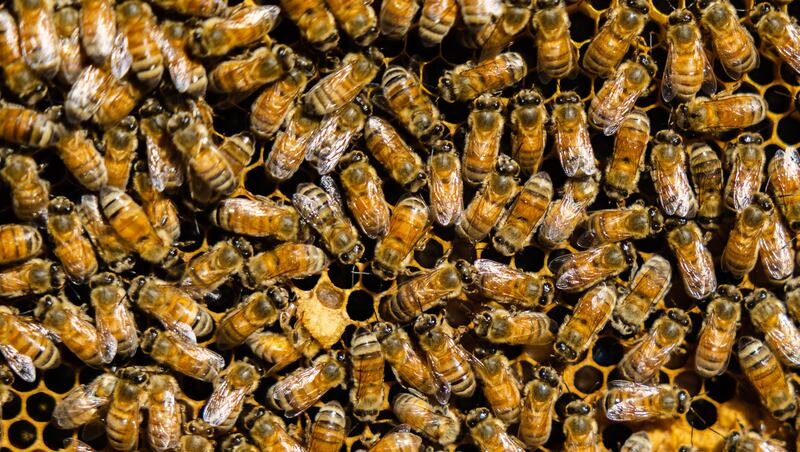Bees are beloved as pollinators and dreaded for their painful stings. But their venom is also hailed by some for medicinal qualities that lessen the impact of chronic pain.
The finding that bee venom could be medicine isn’t new. For years, research has shown a variety of effects: The National Institutes of Health has cited bee venom for anti-inflammatory, antioxidant, antibacterial, antiviral, and antifungal properties, among others.
Healthline reports that “skin health, immunity, motor function and arthritis symptoms” may all benefit from bee venom, “a colorless, acidic liquid that bees excrete through their stingers into a target when they feel threatened.” But the article adds that “it may also lead to adverse effects, so caution is advised.”
If you happen to be one of the estimated 2 million people in the U.S. who the American College of Allergy, Asthma and Immunology reports are allergic to bee stings, you might want to read something else.
What’s in bee venom?
Healthline said that melittin, a combo of 26 amino acids that also gives a sting its painful punch, makes up about half of bee venom’s dry weight. In both mice and in vitro studies, melittin has shown antiviral, antibacterial and anticancer properties.
The peptides apamin and adolapin are toxins, but also have anti-inflammatory and pain-relief-providing properties.
As the nature of bees suggests, good and bad mingle. Painful stings, but beautiful pollination that boosts crops. The enzyme and main allergen, phospholipase A2, causes swelling and cell damage, but it also sometimes reduces swelling and has immuno-protective qualities.
Apitherapy as a healing force?
Using bee products including venom for health purposes, called apitherapy, is a practice both with animal and human care that dates back at least 3,000 years.
And lots of uses have been proposed.
Per Healthline, “Bee-venom injections may be beneficial for inflammation, pain, arthritis, Parkinson’s disease and cancer. However, researchers typically note that more controlled trials are needed to confirm the therapeutic effectiveness of bee venom for these health challenges.” As for chronic pain relief, “bee venom is also used in live bee acupuncture or bee-sting therapy — a treatment method thought to relieve pain in which live bees are placed on your skin and a sting is induced, according to a 2023 review of studies.”
Bee venom and chronic pain
Just over 1 in 5 adults in the U.S. has some form of chronic pain, according to the Centers for Disease Control and Prevention. A news article from the University of North Carolina at Chapel Hill noted research from Kyung Hee University Hospital in South Korea that showed significant pain relief when bee venom was used to treat individuals who had lower back pain.
The article noted that bee venom is also used to manage pain symptoms from arthritis, Lyme disease and scoliosis. Besides noting potential for anaphylactic allergic reaction, though, the article points out that treatment quality is inconsistent and that it’s also “quite expensive.”
A randomized, controlled trial from China on use of bee venom acupuncture for eight weeks to treat people with rheumatoid arthritis — 5 to 15 bee stings every other day vs. a mix of oral Methotrexate weekly and Celecoxib daily — found no significant differences in the results for the two groups, though both groups benefited from the treatments they received. The researchers concluded that “bee-venom acupuncture therapy for (rheumatoid arthritis) patients is safe and effective, worthy of popularization and application in clinical practice.”
Be very careful
Healthline noted risks and potential adverse effects of bee venom therapy, including the potential for life-threatening allergic reactions — that’s the anaphylactic reaction so often mentioned — even if bee venom has been OK in the past. Bee venom can cause local adverse reactions like itching and pain and “severe toxic or neurological reactions.” The latter can include tissue necrosis and persistent burning sensation in the muscles, as well as damage to red blood cells.
A 2023 study in the journal Pharmaceuticals reported that when researchers looked at 145 different studies involving bee venom therapeutically, 58 of those studies (40%) reported adverse effects. The most likely of those were “systemic immune reactions, local reactions, allergies and skin problems.”
As PerfectBee.com reported, “Just because someone can handle 49 bee stings doesn’t mean the 50th sting won’t cause a serious problem.”
Promise is mixed with skepticism in the medical literature. As researchers wrote for Ebsco Information Services in 2024, “Despite its long history and growing interest, scientific evidence supporting the efficacy of bee venom is inconclusive, with mixed results from clinical studies. Safety is a significant consideration, as bee venom can trigger severe allergic reactions, including anaphylaxis. Individuals interested in pursuing this treatment are advised to consult health care professionals and undergo allergy testing before starting therapy.”
The article concluded, “Overall, while bee venom therapy may hold promise for some, it remains a topic of ongoing research and debate within the medical community.”
